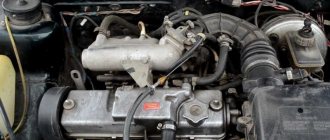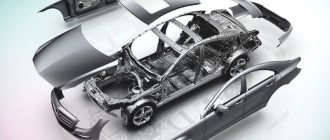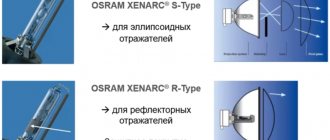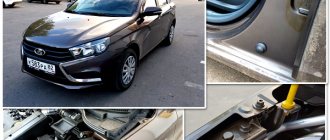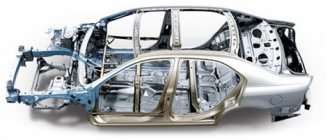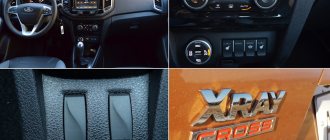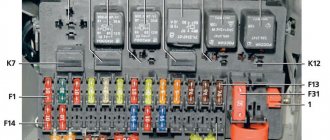It makes perfect sense to purchase a vehicle that will perform perfectly, requiring virtually no repairs, either technical or cosmetic. As you know, scratches, dents, and abrasions do not add attractiveness. As practice shows, it is the body that most often suffers.
Therefore, you need to purchase a car of a brand that will be as resistant to various damage as possible. Galvanization provides the best protection.
Types of galvanization
To choose a machine with such protection, you should familiarize yourself with the possible types of galvanization:
- hot;
- galvanic;
- zinc metal;
- cold.
Zinc is applied by lowering the prepared dry product into a vessel with hot zinc.
According to the type of coating application, they are distinguished:
- full processing;
- partial;
- processing only node connections.
Along with the purchase of a machine with such a coating, the owner receives a warranty card and a document indicating the type of coating, layer thickness, etc.
The situation is much more complicated with cars from an Asian manufacturer. As a rule, the warranty card may indicate a more expensive type of coverage than it actually is. It is quite difficult to check this, since testing for the type of galvanization of the body costs a lot.
Types and types of body galvanizing
Before studying the list of galvanized cars, it is worth familiarizing yourself with the varieties, of which there are only three:
The best method is hot galvanizing. It gives the body high corrosion resistance, making the iron less susceptible to mechanical damage and even has the property of partial regeneration.
Galvanic treatment is a little worse, but is also often used by manufacturing plants. Ideally combined with paint and primer. Zinc metal is significantly worse than the first two options. It has weak anti-corrosion properties, since the metal has only an elastic zinc-based coating.
Galvanization also happens:
- Complete – even hard-to-reach parts are galvanized.
- Partial - nodal connections and vulnerable elements are processed, in particular, the bottom, thresholds, and bottom of doors.
- Only nodal connections - only welding joints, fasteners and other small parts are galvanized.
Hot-dip galvanized vehicles
It should be noted that brands of cars with this type of protection are much more expensive. But the technical side of this issue is fully consistent with the price.
List of vehicles with this coating method:
- Porsche (the first brand was the Porsche 911);
Porsche 911 hot-dip galvanized car
- Volvo - produced since 1975;
- Ford - produced only selectively (“Escort”, “Sierra”, “Fore-Mondeo” assembled in Belgium);
- some models from ;
- Chevrolet (Epica and Lacetti);
Chevrolet Lacetti car with hot-dip galvanizing
- "Fiat Albea" and "Fiat Marea";
- Opel Astra, Opel Vectra.
Opel Astra car with hot-dip galvanizing
It is noteworthy that the first car with such a coating was released. It was they who invented the method of applying zinc to the car body and patented it. Since 1986, all Audi models have come out with such a protective surface.
The most durable SUVs
Many people are now switching from regular sedans and hatchbacks to SUVs. That is why the question of which SUVs are best protected from rust is very relevant.
1.Audi Q8
In first place in terms of the quality of bodywork, of course, is an SUV from Audi.
After all, it was this manufacturer that was the first to produce a galvanized car - it was the Audi 80. Since 1986, all Audi models have been covered with a galvanized coating. The Audi Q8 SUV is very resistant to corrosion; its body is completely hot-dip galvanized on both sides. The manufacturer is not afraid that the body will begin to rust, so Audi provides a 3-year warranty on all its models for paintwork defects, as well as a 12-year warranty against through corrosion. This says a lot.
At the moment, the initial Audi Q8 costs 5,060,000 rubles and this price already includes body treatment.
2.BMW X5
The second place is also occupied by the “German” - BMW X5. This car has always been treated with zinc, in every generation. However, older models are already rusting, and some examples show through corrosion, since the crossover began production in 1999.
Domestic cars
Initially, all protective elements and parts for cars were ordered separately, delivered, and only then assembled the finished vehicle. Naturally, this affected the cost of the car. Now all galvanized parts for VAZ are manufactured at metallurgical plants, so the cost is not particularly affected.
At the moment, the list of domestic cars with galvanized bodies is not rich. They produce only VAZ and UAZ models. Some models of these machines have not only a protective coating, but also some parts. For example, the VAZ 2110 has 47 galvanized parts, not counting the body itself. The type of galvanized model must be checked with the manufacturer. It should be noted that all domestic cars are processed by hot-dip galvanizing.
VAZ 2110 has 47 galvanized parts, not counting the body itself
Cars with a galvanized body will last much longer without requiring surface repairs. This is due to the fact that corrosion will corrode the protective coating, not the metal.
It should also be noted that body galvanization can be applied to those cars that are not on the list. However, it should be understood that this procedure is expensive and time-consuming.
Almost all parts and components of a car can be replaced relatively easily if necessary, even if we are talking, for example, about an engine and transmission. But what to do if a body part becomes unusable? There are fewer problems with the hood and doors, but how to replace the pillars or the bottom? But they are the ones who are most exposed to external factors: moisture, dirt, stone impacts. If a corrosion center has formed on the body, if you let the process take its course for a while, it will be extremely difficult to stop the spread of rust. Therefore, it is so important to provide comprehensive body protection, especially in those places that are not covered with factory paint. However, the paint coating cannot be called reliable protection against corrosion: a small scratch or an unnoticeable chip is enough for water, in contact with air and the metal surface, to lead to its oxidation.
There is a solution to the problem - coating body parts with a thin layer of zinc. Galvanization, performed in a factory, is considered the highest quality and most reliable protective agent against corrosion processes. You don’t have to look far for an example - the famous Audi, produced in the late 80s, that is, about thirty years ago, today will give a head start to much younger competitors when it comes to the condition of the body. Even though they have practically no components left that have not been restored or replaced, you can be sure that during all this time no body repairs have been carried out on such cars. So if you are planning to purchase a new or used car, you should ask in advance whether the body of this model is factory galvanized. It is this topic that we intend to examine with the utmost care.
What are the supposed experts wrong about...
The worst thing is that informational “pearls” that have nothing to do with reality, akin to the fruit of a sick imagination, regularly appear not only among bloggers, but also on the pages of highly respected automobile publications. If you compile the contents of articles devoted to the “galvanization” of bodies, then they will all come down to one seditious quote...
“There are 4 ways to galvanize a body. Here they are arranged in order of increasing effectiveness:
- Cold galvanizing;
- Zinc metal;
- Galvanic method of applying zinc;
- Hot galvanized."
This listing itself already raises serious doubts about the professionalism, competence and level of knowledge of the authors! We will talk about “hot-dip galvanizing”, the mention of which in an automotive context is complete nonsense, in a separate chapter.
Galvanic galvanizing - reality and fiction
Allegedly, “cold galvanizing”, “zinc metal” and “galvanic method of applying zinc” are nothing more than three types of descriptions of the same process - phosphating followed by application of a zinc-containing protective primer to the surface of the body by electrophoresis.
The real differences in the types of this method concern only the nuances: whether passivation is carried out or not, how phosphating is carried out - chemical or electrochemical, what is the composition of the ingredients in the primary electrolyte solution. Of course, first of all, everything depends on quality and adherence to technological culture. But all this is on the conscience of the car manufacturer. The rest does not have any special differences and does not depend on the suppliers of technologies and chemicals.
The second, persistently circulating misconception concerns certain “types of galvanizing”, of which two are almost universally distinguished:
- “full galvanization”, when all body elements inside and outside are coated with zinc;
- “partial galvanization”, when only the most susceptible to corrosion and impact-abrasive areas of the body, usually “to the waist,” are coated with zinc.
The fact is that it makes no sense to phosphate and/or cover the car body with zinc-containing primer “to the waist” or “to the roof” - in any case, the ENTIRE body will have to be treated: either completely, or not do it at all. The technology is such that the body in electrophoresis baths must be constantly rocked and turned over, and the electrolyte must be continuously stirred.
Even immersing the body in the bathtub must be in a position close to vertical, from top to bottom and at a certain speed. If you simply “plop” the body into the bath and, in a semi-submerged state, carry it through the electrolyte, then, after removing and drying, its entire surface will be replete with defects, the soil will lie unevenly, and the thickness of the layer will be extremely uneven. Eliminating defects will require a gigantic amount of manual labor with the negative presence of the “human factor”, and because of this, inevitably huge financial losses. The technology of completely processing the body, completely immersing it in the bath, is absolutely free of all these troubles.
So, we have found out that at present, as before , only one method of galvanizing a body is used in the global automotive industry - coating it in an electrophoresis bath with a thin anti-corrosion layer of zinc-containing substances by electrodeposition onto the surface of the body from an electrolyte, where these substances are contained in form of a colloidal solution.
The time has come to debunk the most monstrous myth about “hot-dip galvanization,” which is steadily circulating in the minds of the automotive community.
“Hot-dip galvanizing” is a figment of a sick imagination
The so-called “hot-dip galvanizing” is not used in the passenger car body industry, has never been used before and (God forbid) will never be used in the future! I would like to make a special point - “hot-dip galvanizing” has NEVER been used and IS NOT USED!!! And that's why …
In terms of beauty and delicacy of the design, the body of the Peugeot 2008 I can be compared with the Eiffel Tower)))
Imagine... A beautiful, openwork, light, almost airy, intricate and complex-shaped body, assembled from many fragments of steel with a variety of characteristics, just welded on a conveyor belt by ultra-precise (!) robots, for galvanizing, it is lowered into... “a bath of molten zinc , the temperature of which is from 500°C to 800°C” - which can sometimes be read not only from bloggers, but also on the pages of highly respected automotive publications.
At 500°C, precision heat-treated body panels... will instantly “release”, and super- and hyper-strong steels will immediately turn into “plasticine”! This should be clear to anyone who has ever stuck a nail into a fire and seen what happens to it after that... At 500°C, the openwork body will experience such high thermal overloads and deformations that it will, in the most literal sense, be torn at the seams! Even if it doesn’t tear, it will twist worse than Quasimode from “Notre Dame in Paris,” and there will be no way to straighten this crumpled piece of foil back!
Lower the temperature? Will not work! The melting point of Zinc is 420°C.
First galvanize the metal, stamp it, and then weld it? It won't work either! The most widely used body welding technology is spot welding. The two parts are tightly connected to each other, compressed in the right place by “pincers” with electrodes, to which a short but powerful electric discharge is applied. Local heating occurs to 1000-1200°C, and the steel is welded at this point.
The next point, another point, another... Now imagine that at the site of this local heating to 1000-1200°C (the melting point of steel) zinc appears with its “ridiculous” melting point of 420°C. This will inevitably lead to the formation of slag, cavities, and burning, which only later, after painting and operation, will become a powerful source of corrosion, incl. and intercrystalline, i.e. internal, without external influence.
Thus, not only will we not protect the body with zinc in any way, but, on the contrary, we will create a huge number of sources for hidden and uncontrolled corrosion to occur. After exposure to vibrations, the weld points will begin to crack and burst, and after some time the body will fall apart at the seams.
By the way, modern technologies, especially those of the PSA Peugeot Citroen Group, have successfully solved this problem! Before connecting the surfaces of steel parts coated with a thin layer of zinc for subsequent spot welding, a special preservative flux is applied to their inner sides facing each other, which eliminates the burning out of zinc and promotes its instant dissolution in the center of molten steel without the formation of slag and defects. The flux located around the welding point and not taking part in the reaction now plays the role of glue, which, after rapid polymerization, not only seals the joint of the parts, protecting the welding point from the inside, but also helps to further increase the rigidity of the structure.
But let’s return to “hot-dip galvanized”
Energy ! Calculate - what a monstrous amount of energy needs to be supplied to a “zinc molten bath” with a capacity of more than 150 m3!!! In addition, this entire volume must be constantly kept at a temperature of at least 500°C, constantly adding and melting new zinc granules! What if the car is produced in a circulation of 500,000 cars per year?
That's 41,670 cars per month, 1,389 per day and 58 cars per hour! This means that you need to lower 1 body per minute into a bath of molten zinc (around the clock, without holidays or weekends!)! ... In this case, next to the automobile plant there should be some kind of nuclear or hydroelectric power station of the “caliber” of the Dnieper Hydroelectric Power Station!
Carving ! On any body, no matter how high-tech it is, there will always be many and different threaded holes in it! The thinnest layer of zinc that can be achieved with hot-dip galvanizing is 0.1 mm! Not microns, but one tenth of a millimeter! There is no way to make the layer thinner using this method. If you cut a thread before galvanizing, then after applying a layer of 0.1 mm to its turns, even if it is M16, it will hardly be possible to screw a bolt into this hole, not to mention threads of a smaller diameter. If you cut a thread after galvanizing, then the whole point is lost - after the tap comes out of the hole, there will be “bare metal” on the surface of the threads, open to any corrosion and unprotected by anything.
Ecology ! In this case, I’m not talking about Greta Thunberg, but about real ecology. Zinc, after it has been melted, let alone brought its temperature to 500-800°C, begins to actively oxidize and react with everything “that comes to hand”, the result is a huge amount of harmful slag that cannot be further processed, poisonous gases and evaporation... Where should all this go? Gases into the atmosphere, and slag into the street? With a “rate of fire” of 1 body per minute, in a year huge stinking waste heaps will rise around the plant, poisoning everything around with miasma. “Birds don’t sing here, trees don’t grow here” (C) will become a terrible reality.
Hot-dip galvanizing is used in the manufacture of lamp posts, water pipes, fences, bridge elements and similar products - where high precision is not needed, and the part is a body part. In the automotive industry, this method is extremely rarely (!) used for galvanizing any brackets for trucks, their frames, struts, etc.
Today, the best, only and well-developed “galvanizing” technology is the technology of electrodeposition onto the surface of the metal body before painting it.
- Environmental friendliness is almost one hundred percent, because no toxins or harmful emissions occur at all.
- Energy consumption is minimal and is required only to maintain the required potential difference on the body and bathtub.
- The layer of zinc-containing coating is thin, about 10 microns, so it does not affect even the smallest body threads.
- The layer is very durable, since microparticles penetrate the surface of the body panel at the molecular (!) level.
- Everything is galvanized, right down to the most delicate nooks and crannies of the body.
- To eliminate defects due to inevitable bubbles, the body is turned over while in the bathroom, and the electrolyte is constantly mixed.
- Drying a newly galvanized body by electrodeposition occurs in the same way as drying after painting it - with a stream of sterile air under infrared lamps.
- A priori, the body cannot experience any heating, and therefore internal temperature deformations and associated stresses.
We will leave for later and at your request a description of new, advanced, albeit exotic technologies that have recently begun to be used in car production (including Peugeot, Citroen and all Stellantis products), but which are the future: gluing, lamination, plasma spraying, etc.
The final inspection of the quality of painting and body assembly on Peugeot and Citroen is carried out by gentle female hands - affectionate, sensitive and very beloved by us)))
Automotive galvanizing methods
For a polished but untreated steel structure, one rain is enough to start the oxidation process of the metal. The presence of several layers of paint and varnish will protect the surface from moisture, but who will protect the paintwork itself? With the lack of free space in modern cities, finding a car with an unscratched body is not an easy task. But even a small but deep scratch is enough for rust to appear in this place, spreading to nearby areas.
Hot galvanized vehicles
Since the method of galvanizing metal surfaces using the hot method is quite complex and requires the use of expensive equipment, it has a significant impact on the final cost of the car, and this fact must be taken into account. Few automakers are concerned enough about the anti-corrosion properties of their products to use this technology. Therefore, the list of cars with a hot-dip galvanized body is not so long. First of all, it is worth noting the cars of the VW Group, which has been using this technology for almost three decades. These are cars of the following brands:
Some Ford, Volvo and GM models produced at specific enterprises are also characterized by the presence of galvanized bodywork, made using a thermal method. All these cars can be safely classified as premium class in terms of corrosion resistance, as evidenced by numerous laboratory tests in salt chambers, which have proven the excellent performance characteristics of such a coating.
As noted earlier, the pioneer in the use of hot-dip galvanizing technology is the Audi automaker, which even today spends a lot of money on research in the field of tread technologies. An example is the patented technique of applying a layer of zinc on both sides to all body parts. Welded seams are subject to the same protection. Let us note that the trend in recent years has been to lighten the car structure, which involves a large share of aluminum in the car frame, which somewhat reduces the cost of hot-dip galvanizing, making the product cheaper and more competitive. Here is a list of cars with hot-dip galvanized bodies:
- all Audi models;
- Ford Escort;
- selected Ford Sierra models;
- latest generation Chevrolet Lacetti and Epica;
- new Opel Astra/Vectra cars;
- Fiat (Albea/Marea);
- Cadillac;
- Buick.
Content:
- 1 Types of galvanization
- 2 Hot-dip galvanized vehicles
- 3 Galvanized models
- 4 Domestic equipment
Galvanization of elements acts as a panacea for such problems. It allows you to protect your car from an impressive list of damages. Let's figure out what it is, how it works, and who uses it.
Galvanized car
The main advantage of this technology over thermal processing methods is lower cost, so this method has become more widespread, and the list of car brands with galvanized bodies is much wider. It is most often used by Japanese and North American automakers, although it is also found in the Old World. Note that due to the lower efficiency of such coating, some European brands (we are talking about such giants as BMW and Mercedes) are working hard to improve the galvanic galvanizing method, using the following techniques to increase the anti-corrosion characteristics of their cars:
- For the manufacture of body parts, only high-alloy steel is used, characterized by a minimum content of impurities;
- provide a fairly thick layer of zinc (within 9-15 microns);
- treat the metal surface with a thick layer of primer and paintwork over zinc, using the improved adhesive properties of galvanized surfaces.
If we talk about the products of the Japanese automobile industry, then the quality of galvanizing is inferior to European ones, since local automakers began to use galvanizing much later than their European colleagues. Toyota cars deserve the most attention, which today have a fairly thick layer of zinc on all parts exposed to corrosion.
Now let’s look at which car bodies are galvanized using galvanic technology:
- Alfa Romeo (models that came off the assembly line after 1993);
- Mercedes W124/W201;
- Audi A4;
- Lexus;
- Mitsubishi (Lancer 9);
- Volkswagen (all models starting from 2000);
- Toyota (since 1991);
- Skoda (Fabia/Octavia models);
- Honda (Legend model only);
- Peugeot;
- Renault (Espace 3, Logan);
- Chrysler (model 300M).
Galvanized cars of domestic production
If we talk about the domestic automobile industry, then the situation with galvanizing the body is much worse. Previously, AvtoVAZ products were made from finished steel billets supplied from abroad. Some examples may indeed have been assembled from galvanized steel, but certainly not in large numbers. But even without anti-corrosion treatment, the cost of cars made from imported steel was too high, so AvtoVAZ employees switched to using local steel. Many body parts are galvanized, but this uses a cold process, which provides the least protection possible. In addition, this method involves galvanizing individual parts, and not the entire body, so we are not talking about complete protection.
Some components and parts are subjected to anti-corrosion treatment using the cataphoresis method without the use of zinc. Accurate information about the presence/absence of a galvanized layer on domestically produced cars is quite difficult to find. In relation to AvtoVAZ products, the list of models with a galvanized body is as follows:
- VAZ 2110 (about 30% of parts are galvanized);
- Lada 4x4 – only cataphoretic primer, no galvanized surfaces;
- Kalina (first generation - 52%, second - full galvanized, with the exception of the roof, side members and hood);
- Priora (29% since 2008, 100% since 2009);
- Granta (liftback – wings and doors are galvanized, sedan – without galvanization);
- Vesta – completely galvanized, except for the bottom/sills (the sedan’s roof is also not treated);
- XRAY – fully galvanized, except for the roof.
Cold galvanizing
The last method is cold galvanizing. This method is similar to the previous one in technology, but this one is even simpler and cheaper. Some car owners can process body parts using this method in their garages. The car does not need to be immersed in a special zinc-containing solution for this. The solution itself is applied to the body using an electrode, which is connected to the positive terminal (the car body is connected to the negative terminal). Some car repair shops offer a service for processing car body parts, but complete processing cannot be done this way. Since this method is not used by car manufacturers, it is not worth describing it in detail.
How to find out whether a car is galvanized or not
So, if you want to own a car with a galvanized body and are willing to pay a little extra for it, you will need an accurate way to find out whether a particular model has been subjected to such treatment. Moreover, this is true for both new and used cars (in the second case it is even more significant). Unfortunately, we would not recommend taking the word of sellers, even if they are representatives of a well-known brand car dealership. The first thing you need to do is look at the technical characteristics of the machine. If you haven’t come across the word “galvanization”, you can say with confidence that there is practically no anti-corrosion protection for body parts. But even otherwise you need to be careful. Only the presence of the phrase “full galvanization” suggests that the entire body was processed, and not its individual elements.
Partial galvanization is practiced much more often; most models produced today have just such incomplete protection of the body from moisture. The lower the cost of a car with the same equipment, the worse its ability to resist oxidation - galvanizing, priming and paintwork on budget cars is carried out using the most affordable materials and technologies. Economy class models from Asian automakers are especially guilty of this. Unfortunately, it is not possible to independently determine whether the body is galvanized or not. To do this, you need to use a fairly expensive technique, which even many large service centers cannot afford. You can subject the car to galvanization testing, but its cost may be so high that there will be little point in this step.
From the above material, it can be assumed that the bodies of many European, Asian and American-made cars are processed using the galvanic method. Thermal technology is less common, but recently, thanks to the efforts of German manufacturers, the cost of such galvanizing has been steadily decreasing, approaching the cost of the galvanic method. Note that we did not mention another method of applying zinc to a steel surface. Zinc metal technology does not have good tread properties, so few manufacturers use it - in particular, the Korean company Kia.
When purchasing a new car, among other documents, you receive a warranty card, which states the warranty period against through corrosion of the car body. We advise you to treat this piece of paper with special attention - if body defects appear during the warranty period, you can save a considerable amount of money on restoring the integrity of the body part damaged due to poor processing, and in some cases you can even replace the defective car with another.
Summarizing the above, we note that the main source of information about body galvanization is the technical documentation for a specific model, as well as the availability of an appropriate warranty. Technical verification methods exist, but they are complex, expensive and therefore cannot be ordered everywhere. We also note that you should not trust advertising materials - the level of marketing today is very high, and manufacturers resort to numerous tricks, citing facts that turn out to be only partial truth, or even completely misinformation.
The best prices and conditions for the purchase of new cars
Is it possible to do galvanizing at home and what is required for this?
Galvanizing a car body with your own hands is quite possible, but it does not imply complete, but partial coating of certain elements with a protective layer. These may be areas that are most susceptible to corrosion: fender liners, sills, areas under the feet of the driver and passengers, door cards, as well as places where the paintwork is damaged.
The home method of applying zinc protection is something between cold and galvanic galvanization. But more on that a little later. And now about what is required for this.
Required tools and tools:
- latex gloves;
- zinc chloride or sulfate (soldering acid);
- a piece of zinc;
- glass vessel;
- car battery or charger;
- a piece of clean rag (gauze);
- sandpaper;
- degreaser (solvent);
- baking soda solution.
If you do not have the opportunity to purchase a ready-made zinc salt solution, you can prepare it yourself. To do this, take sulfuric or perchloric acid and dissolve pieces of zinc in it in a ratio of 1:0.4, i.e. for one liter of acid – 400 g. metal
This is done as follows. Pour acid into a glass container (glass, jar) and immerse zinc in doses until they stop interacting. The reaction occurs in the form of dissolution of the metal with the release of hydrogen. Therefore, be extremely careful: work with gloves and away from open heat sources. When the reaction stops, the solution can be considered ready. Filter it and drain the precipitate. Now you can begin the actual process.
Cars with galvanized body
Every car driver has wondered how to protect his car from corrosion. As soon as corrosion appears, it immediately becomes visible, and the car no longer looks beautiful and presentable. Therefore, cars with galvanized bodies will last you a long time only if the zinc becomes only part of the overall barrier, and not its basis.
It is imperative to apply this approach to second-hand cars. Do not forget that even cars with a galvanized body must be periodically inspected and treated with anti-corrosion treatment, otherwise the car will quickly become unusable.
- Alfa Romeo: 164 from '93
- Audi: 80, 100, A4, A6 (94-97), all models after 2000
- Chevrolet: Lacetti, Epica
- Chrysler: 300M
- Fiat: Albea, Marea
- Ford: Mondeo (Belgian assembly), transit (since 2000)
- Honda: Legend
- Iran Khodro: Samand
- Mercedes: W201 and W124 (discontinued in 1993 and 1995, respectively)
- Mitsubishi: Lancer 9
- Opel: Astra, Vectra B (after restyling 2012), Vectra C
- Peugeot: 306 (since '95) 307, 406 (after 2000), 605, 806
- Porsche: 911
- Renault: Espace lll, Logan
- Skoda: A4, Fabia, Octavia
- Subaru: Legacy (European variants)
- Toyota: Corolla E10 series from 91-97, Carina 88-96
- Volkswagen: Golf 3, almost all models after 2000
- Volvo: All models from 240th
If you know what can be added to the list, write in the comments.
AnatoliyK › Blog › Cars with galvanized bodies
Cars with galvanized bodies: list Found on the Internet. I saved it for myself. Over time I think it can be edited.
Maybe someone else will find it useful.
— “Alfa-Romeo” (galvanized models have been produced since 1993); — “Peugeot” (most models produced since 1995); - “Porsche”.
The first fully galvanized car of this brand was the Porsche 911; - Volvo.
Volvo has been producing cars with galvanized bodies since the 240th model, that is, since 1975; - "Ford". Galvanizing is not carried out for all models. Ford Escort and Ford Sierra have galvanized bodies.
There they will then begin to sculpt the Corolla 110 Restyle, 120, Rav4, Avensis, Yaris, in general, the entire budget LR almost in full cycle. Its VIN starts at SB1, and the galvanization of only the arches and bottom is obscene and rots badly.
There are left-hand drive Carinas from the first years, which were made in the Japanese division (VIN JT1), their galvanization is excellent. Toyota Carina E 97 and it doesn’t smell like galvanized steel, another year or two and there won’t be a living place left on it. Take my 101 Corolla from 1995. or my father’s 110th Dorestayl from 1997, both are left-hand drive - both have the same sills and a healthy bottom even without additional ones.
Is the car body galvanized - how to determine?
The galvanized layer will perfectly protect the metal from rust and extend the life of the car for a long time.
The types of galvanizing are as follows: The Kia automaker has gone its own way. The body elements of the cars of this automaker are made of zinc metal, reminiscent of “puff pastry”: This type of galvanizing is a marketing ploy that was invented by manufacturers of budget cars.
Cold galvanizing is the coating of elements with cathophoresis primer containing zinc.
Cars with hot-dip galvanized body list
Since 1986, all Audi cars have been produced with an anti-corrosion layer applied to all surfaces of the body.
- From the point of view of operational characteristics, thermal galvanizing technology is more preferable:
- cold galvanizing.
- galvanic galvanization;
- hot galvanizing;
- resistance to mechanical stress is maintained throughout the entire service life;
- coating durability is 3-4 times higher than with the galvanic method;
- the corrosion resistance of the metal remains for a long time (from 15 years and above, depending on the thickness of the coating);
- The coating at the local level has the property of regeneration (self-healing).
Factors that determine cost
Galvanizing a body cannot be called a cheap procedure. The cost of the service is influenced by the following factors:
- Processing technology.
- Workload.
- Composition used.
- Thickness of the zinc layer.
- Difficulty of work.
- Equipment used.
- Class, make of car.
- Dimensions of the structure.
- Rating and pricing policy of the service company.
- Availability of current discounts.
- The city where the service is provided and the level of competition there.
Cars with hot-dip galvanized body list
The galvanized body has excellent resistance to mechanical stress and the ability to regenerate (self-heal) at the local level.
Considering all the above nuances and pitfalls, many will be interested to know which cars, ours and foreign cars, have a galvanized body.
- Buick (Buick);
- Cadillac (Cadillac);
- Fiat Albea (Fiat Albea);
- Fiat Marea (Fiat Marea);
- Chevrolet Lacetti (Chevrolet Lacetti);
- Chevrolet Epica (Chevrolet Epica);
- Opel Vectra (Opel Vectra);
- Opel Astra (Opel Astra).
All hot-dip galvanized machines are tested in a salt chamber and demonstrate excellent resistance to corrosion.
- application of the welding-soldering method;
- painting using technologies that form a protective oxide layer on the metal;
- primer and paint containing zinc (cold galvanizing).
When repairing a vehicle body with a zinc-containing coating with your own hands, it is important to know and remember that galvanized metal should not be sanded under any circumstances.
Which cars have a galvanized body and how is the coating applied?
The manufacturer gives modern cars with a galvanized body a very impressive warranty period - from 5-6 to 30 years. The number of zinc coating methods actively used in the automotive industry is 3:
- hot galvanizing;
- galvanic galvanization;
- cold galvanizing.
From the point of view of operational characteristics, thermal galvanizing technology is more preferable: The technology of applying a protective coating using the hot-dip galvanizing method is difficult to implement and requires large capital investments.
This technique is actively used by the VW Group on all brands of cars owned by it:
Literally all cars with a body galvanized using first-class technology demonstrate excellent resistance to the occurrence of corrosion spots during aggressive tests in a salt chamber. Answering the question of which cars have a hot-dip galvanized body, you can also give the following examples:
- high-alloy steel with minimal inclusion of harmful impurities;
- a layer of zinc 9 – 15 microns thick, applied by galvanic method;
- a thick layer of paint applied to a perfectly flat surface with good adhesion.
Galvanizing as a common method of corrosion protection of metals
When creating high-quality and durable metal coatings, galvanizing technology is most often used. This is due to the low cost of consumables and excellent results. Galvanizing itself occurs using the simplest technology. Its implementation does not require additional costs and a lot of effort, which allows such processing to be carried out at home.
Cold galvanizing – protecting metal from corrosion
The zinc coating is formed as a result of the fact that zinc enters into an oxidation reaction with oxygen present in the air. Subsequently, a strong protective film is formed on the surface of the metal being processed, which protects it from the negative influence of the external environment.
Zinc is a more active metal than iron or steel. Therefore, it primarily interacts with oxygen and water, preventing corrosion. Even if at least part of the coating is present on the surface of metal products, it protects it from destruction.
List of cars with galvanized body
Now let's look at what methods there are for factory galvanizing a body: When deep scratches appear on the body, the zinc is the first to suffer; metal does not rust.
This is the main advantage of the cars in question.
- Partial. Treatment of welds and vulnerable areas of the body (bottom, sills, doors).
- Processing of node connections. Only areas of stampings, fasteners, and welds between sections of the body are coated with zinc.
Now consider specific brands and models of cars with galvanized bodies.
The list will be quite extensive, so we also classify the machines according to the method of applying the anti-corrosion material.
- Porsche (the first of the models with such a body is the famous Porsche 911).
- Audi.
- Volvo.
- Ford.
- Chevrolet (Lacetti).
- Opel (Astra and Vectra).
The first production car with a fully galvanized body was the famous Audi 80. After it, most of the cars of this company came with a mandatory anti-corrosion coating.
Depending on the brand, the coating could have a thickness from 2 to 10 microns. Now let's look at which cars are coated with the classic galvanic method: Car models from Toyota deserve special attention.
Since the company previously paid little attention to anti-corrosion treatment, now a layer of zinc in joints, thresholds and doors is present in most cars.
The cataphoresis treatment method is also used
Cooling radiator
Troubles are also possible with him. They can be caused by three reasons:
- The most harmless option: wait until it cools down, the traffic jam is over - and you drive on with a light heart;
- the core is clogged inside with refrigerant deposits or dust. The pressure through the radiator drops, cooling is insufficient;
- scale and deposits in the pipes. The thermal conductivity of the hoses decreases, and the liquid does not have time to cool again.
Except the first option
Water pump:
It most often fails in those machines where torque is supplied to the pump pulley separately from the gas distributor. The pulley rotation speed may decrease if the drive belt is loose (stretched). After making sure that your thermostat is normal, try tightening the belt and driving after the engine has cooled and topped up the coolant.
Fan:
If the fan is killed, this is the easiest reason to determine. Even if the car does not have a corresponding sensor warning that the fan is not working, a person who is not behind the wheel for the first time will hear it by sound. In the city and slowly, with a non-working fan, you can get to a repairman. Outside the city, we are looking for a tug.
Cars with hot-dip galvanized body list
For example, Ford Escort and Ford Sierra have galvanized bodies. But “Ford Mondeo” - not always (only Belgian assembly); Models from General Motors. Most parts are galvanized only in some models of Chevrolet (Chevrolet Lazetti, Epica), Fiat (Fiat Albea and Marea), Opel (Opel Astra and Vectra), Cadillac and Buick.
The legendary Audi 80 became the first production galvanized car. Since 1986, all Audi cars have been produced with an anti-corrosion layer applied to all surfaces of the body.
Application of zinc melt on steel, zinc layer 2 - 10 microns Audi has patented a technique that implements double-sided zinc protection not only of the body, but also of restructured welded joints. Due to the reduction in production costs, BMW and Mercedes were able to create their own recipe for car protection: high-alloy steel with minimal inclusion of harmful impurities; a layer of zinc 9 – 15 microns thick, applied by galvanic method; a thick layer of paint applied to a perfectly flat surface with good adhesion.
How is galvanizing carried out?
This method is simpler and more concise, but less effective. However, automakers still provide long-term warranties for cars treated in this way.
The process of applying an anti-corrosion layer by galvanic method is simpler:
- The car body or any of its parts is immersed in a container containing an acidic zinc solution.
- The negative terminal from the power source is connected to the body.
- The capacitance itself is connected to the positive terminal.
With this connection, electrolysis occurs in the container. As a result of this process, zinc particles dissolve and stick to the car body. This is how a protective layer is formed, which also prevents the oxidation process and repels moisture. This method is simpler and cheaper.
The leaders among automakers that galvanize their cars are BMW and Mercedes.
Full galvanization of the car body: truth or advertising tricks of manufacturers?
To understand how things really are, you must first become familiar with the three well-known methods of galvanizing metal elements of car bodies.
The manufacturer himself often gives a truly long warranty on the body.
Sometimes the indicators reach up to 30 years.
The minimum service life of such vehicles is about 15 years. In addition, we can note some other models of the European automotive industry that are processed by thermal galvanization:
- Some Ford Sierra models;
- Ford Escort;
- Latest Chevrolet Lacetti models;
- New models of Opel Vectra and Astra.
Bodies galvanized by the galvanic method have a slightly lower cost than those that have been subjected to heat treatment.
Let's sum it up
Now we know which cars have a galvanized body. The lists are gradually increasing as manufacturers are able to use proven and inexpensive methods, for example, adding zinc to primer or paint. Therefore, you need to take into account some nuances highlighted by auto experts:
- Reliable protection of the vehicle body by galvanizing is possible only with expensive models, since investing in budget options is considered unwise - they simply will not pay for themselves.
- In the modern world, the level of body preparation is much worse than it was 10-20 years ago. While cars produced in the 1990s were built to last for decades, today this period has been reduced to 7 years, after which the car can be scrapped. Therefore, you should not believe dealers who claim that the service life of any new model is at least 10 years, because its body is galvanized - this is a marketing ploy, nothing more.
- In the technical specifications, any manufacturer may indicate that the machine is galvanized, although in fact it is not. At least this applies to the already mentioned budget models, when only some body elements were subjected to this procedure.
